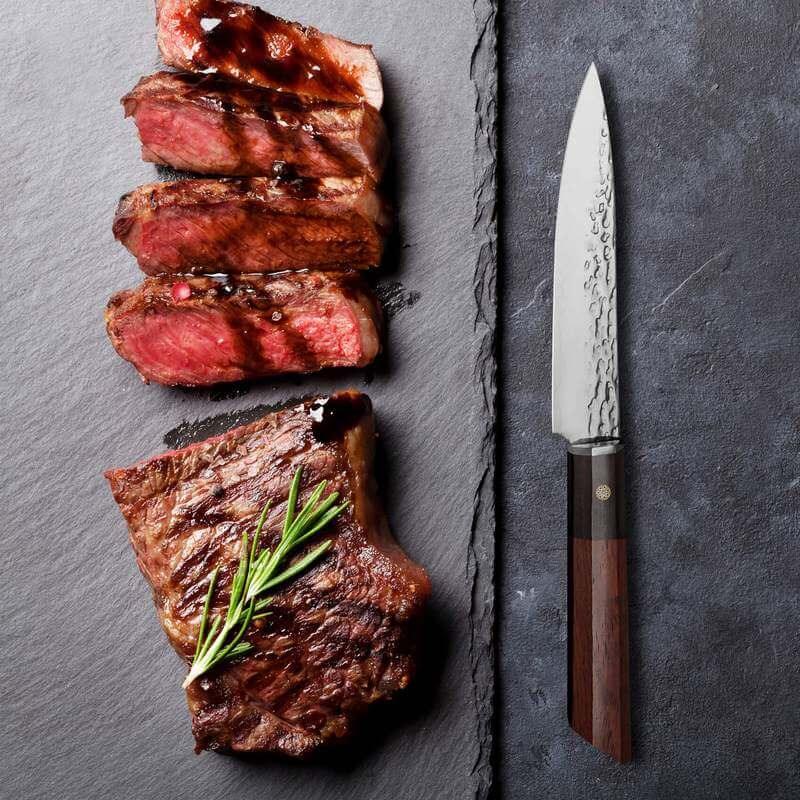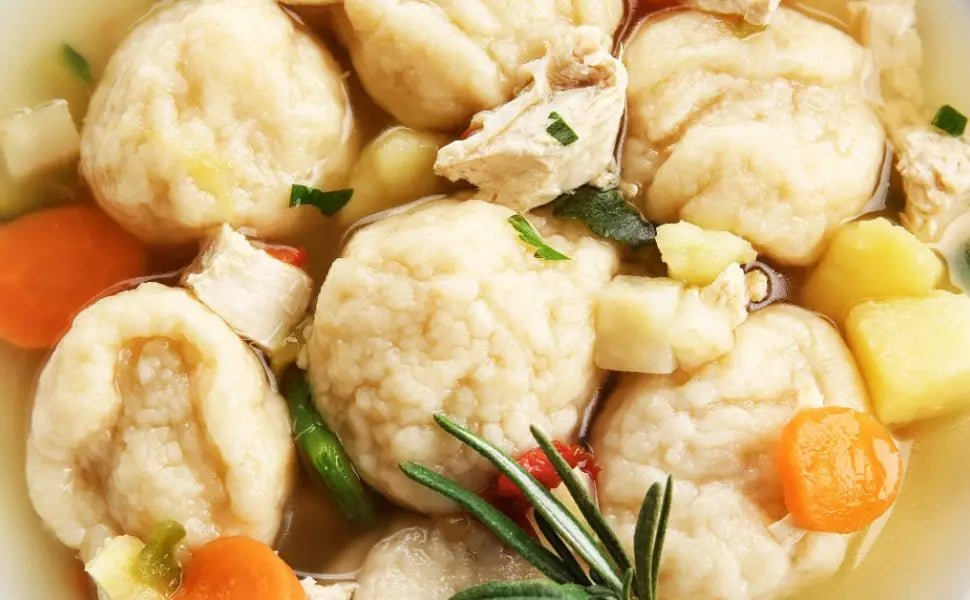TABLE OF CONTENTS
Whether it's veggies, fruits, meat, or those cheese slices - the culinary world involves different cutting techniques to transform raw food items into finer pieces with different shapes and sizes. Two of the most common cutting methods in the kitchen are chopping and dicing. You need to decide what technique you are going to use depending on what exactly you are preparing.
Chopping and dicing are often confused and thought of as the same thing. However, they are quite different from each other, with varying end results. Here's an in-depth discussion on chopped vs. diced that takes you through the difference between the two, as well as how to pull off the two methods.

Chopped Vs. Diced
Speaking of Chopped Vs. Diced, the main difference between the two lies in the size of the cut pieces and the way they look in terms of uniformity and shape. The two techniques are often associated with different kitchen knives and cutting styles to get the desired shape and chunk size of the ingredients to be cut. Both the methods yield pieces that have their own purpose when preparing and serving the final dish.
What is Chopping?
Chopping is a knife technique wherein the ingredients are usually cut in large chunks. The exact size of the pieces largely depends on the recipe and the dish you are preparing. Usually, soups and salads are made with smaller pieces of chopped fruits and vegetables. Chopping goes for numerous recipes and makes one of the larges cut pieces of all knife cuts. Most recipes mention the required size of the chopped ingredients with terms like finely chopped or roughly chopped.
If a recipe doesn't specify a size, chopped food usually ranges from half an inch to three-fourths of an inch. Chopped pieces are always larger in size as compared to diced or minced ingredients. And the size of the chopped pieces also influences the time taken to cook a dish. When going for small chopped pieces, you usually stick to one-fourth of an inch, but it doesn't need to be precisely done.
If going for roughly chopped chunks, you stick to around three-fourth of an inch, wherein the pieces of similar in size, but they can be irregular in shape. Because your hands move quite fast while chopping, it doesn't take much to cut the ingredients, but it takes a lot of force. The professional chopper knife-Cleaver Knife 7" enables you to cut any food like a pro chef.

What is Dicing?
Dicing is a knife technique where ingredients are cut into smaller chunks or cubes. The idea is to get precisely cut pieces that are often uniform in size and shape. Dicing can be done for culinary purposes or for beautifying veggies and fruits.
Dicing the ingredients makes them bring out an evenly distributed texture and flavor to the whole dish. While dicing items, you work up pieces that are about one-fourth to one-eighth of an inch. You need to make smaller cubes, making the process more time-consuming and calling for more concentration.
Dicing is usually done in three different cube sizes, i.e. large cubes, medium cubes, and small cubes. A smaller diced cube is about one-fourth of an inch, a medium dice is about half an inch, and a large dice is about three-fourths of an inch. The most commonly diced veggies include tomatoes, potatoes, and carrots, as it helps them cook faster. If you are making casseroles or preparing a mixed vegetable dish, it's a good idea to go for dicing.
How to Chop
Usually, chopping is more about the size of the cut pieces instead of the exact shape. Chopping is part and parcel of almost all home kitchens, and different recipes call for different types of chops, including a fine chop, a rough chop, and a standard chop for most meals. Small ingredients, like herbs, garlic and ginger, often need to be chopped, just like items used for blending or turning into a puree.
The back-and-forth rocking technique is the most convenient way to chop ingredients. To pull off the technique, you need a sharp chef's knife and a chopping board. A chef's knife features a curved cutting edge that makes it easy to move over the ingredients and create quick, large cuts.
First, peel the skin and remove the stem or inedible seeds, further putting whatever you are planning to cut on the chopping board. Grab the knife that places its tip above the ingredient, while firmly resting the other hand on the blade's spine. It's time to rock the blade down in different angles over the item you are cutting. Make sure the blade's tip never leaves the board as you rock the knife. In between, you can always bring the cut pieces back together to continue chopping.
If you need to make rough chops on large ingredients, you can also lightly hold the item in place with one hand. Make sure to prevent cutting your fingers by curling the fingertips in a claw-like style. You can simply slice the ingredients at big gaps of about half to three-fourth inches. Next, take the individual slices and cut them again in the opposite direction. Keep chopping until you get large roughly chopped pieces in the required size.

How to Dice
Dicing is all about creating a uniform and small pieces of the ingredients you are cutting, and that's why it calls for more precision. Diced food items often work as ingredients to a dish, side servings or toppings. Some use diced fruit to prepare sauces, diced veggies as pizza toppings and soup ingredients.
The fact that you make small pieces when dicing ingredients make sure that things cook better and evenly. At the same time, it makes the served meal look better. What you need for dicing are a sharp knife and a chopping board. You may need to choose a serrated knife, if you are cutting soft stuff like tomatoes, while thick items call for a chef's knife. The idea is to transform ingredients into a simple shape from an irregular one before starting to dice them.
Let's take a carrot for example. Start by peeling the carrot and cutting it in half or thirds. Place one piece on its wider end and make 4-5 even slices from top to bottom. Lay half the slices on top of each other and curl your fingertips underneath them to hold them firmly.
Guiding the knife's face along with your fingers, cut the veggie into strips the same width as the thickness of the slices. Next, group the carrot strips together and hold them with your fingertips curled under, further guiding the face of the knife along with those fingers. Move the knife back and forth on the blade's front half while cutting with the back half of the blade.
However, dicing an onion calls for a different style. You need to peel it first, then make sure that you maintain your tucked fingertips whenever you cut. Once you remove the pointy end, put the onion on its flat side, further cutting it half down the center. Lay each half flat and make 4-5 horizontal incisions almost all the way through the onion. Cut 3-4 incisions from the round top to the onion's flat bottom, leaving just a little far from the base.
The idea is to cut the onion into a grid-like form that's still held together at the bottom. Run the knife along the grain, and the onion will fall into a proper dice cut on the knife's other side.
Most other food items simply call for cutting off uneven sides to get a square or rectangular block, further dicing it to the required size. Anything cooks faster when it's diced in smaller pieces.
The Importance of Knowing When to Chop or Dice
Both the cut methods, chopping and dicing have their own specific purpose in different recipes and dishes. And that's why you can find the mentioned texture, flavor and chopping style in most good recipes out there. The shape of the cut ingredients makes a big difference in determining how the dish tastes, looks and feels on the tongue.
If you go for chopping the ingredients for a dish that calls for dicing them, you may end up with undercooked bits. On the other hand, if you dice when the dish calls for chopping, the final dish may look quite pulpy or sloppy.
For example, in mixed vegetable soups, tomatoes and mushrooms cook much faster than carrots and celery. To ensure evenly-cooked ingredients and a uniform texture throughout the meal, the idea is to dice celery and carrots into smaller pieces and add them to the cooking pot earlier.
If you are preparing a dish that doesn't call for cooked ingredients, some of them sport a better texture when diced while others are better in chopped form. For example, onions are better when cut into smaller diced pieces, while a soft avacado is better when you cut it into larger pieces to prevent it from getting a mushy texture.
The key is to plan the desired taste and texture of the dish before you start with the preparations. After all, it's your meal and your creation, so it entirely depends on how you want it to look and taste. And that's all that goes into deciding the size and style of the cut ingredients, whether chopped or diced.






















Leave a comment
All comments are moderated before being published.
This site is protected by hCaptcha and the hCaptcha Privacy Policy and Terms of Service apply.